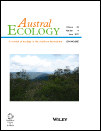Ver ítem
- xmlui.general.dspace_homeCentros Regionales y EEAsCentro Regional Patagonia SurEEA Santa CruzArtículos científicosxmlui.ArtifactBrowser.ItemViewer.trail
- Inicio
- Centros Regionales y EEAs
- Centro Regional Patagonia Sur
- EEA Santa Cruz
- Artículos científicos
- Ver ítem
Decomposition and nutrient release of grass and tree fine roots along an environmental gradient in southern Patagonia
Resumen
Decomposition of fine roots is a fundamental ecosystem process that relates to carbon (C) and nutrient cycling in terrestrial ecosystems. However, this important ecosystem process has been hardly studied in Patagonian ecosystems. The aim of this work was to study root decomposition and nutrient release from fine roots of grasses and trees (Nothofagus antarctica) across a range of Patagonian ecosystems that included steppe, primary forest and silvopastoral
[ver mas...]
Decomposition of fine roots is a fundamental ecosystem process that relates to carbon (C) and nutrient cycling in terrestrial ecosystems. However, this important ecosystem process has been hardly studied in Patagonian ecosystems. The aim of this work was to study root decomposition and nutrient release from fine roots of grasses and trees (Nothofagus antarctica) across a range of Patagonian ecosystems that included steppe, primary forest and silvopastoral forests. After 2.2 years of decomposition in the field all roots retained 70–90% of their original mass, and decomposition rates were 0.09 and 0.15 year−1 for grass roots in steppe and primary forest, respectively. For N. antarctica roots, no significant differences were found in rates of decay between primary and silvopastoral forests (k = 0.07 year−1). Possibly low temperatures of these southern sites restricted decomposition by microorganisms. Nutrient release differed between sites and root types. Across all ecosystem categories, nitrogen (N) retention in decomposing biomass followed the order: tree roots > roots of forest grasses > roots of steppe grasses. Phosphorus (P) was retained in grass roots in forest plots but was released during decomposition of tree and steppe grass roots. Calcium (Ca) dynamics also was different between root types, since trees showed retention during the initial phase, whereas grass roots showed a slow and consistent Ca release during decomposition. Potassium (K) was the only nutrient that was rapidly released from both grass and tree roots in both grasslands and woodlands. We found that silvopastoral use of N. antarctica forests does not affect grass or tree root decomposition and/or nutrient release, since no significant differences were found for any nutrient according to ecosystem type. Information about tree and grass root decomposition found in this work could be useful to understand C and nutrient cycling in these southern ecosystems, which are characterized by extreme climatic conditions.
[Cerrar]

Fuente
Austral Ecology First published: 25 October 2018
Fecha
2018-10-25
Editorial
Wiley
ISSN
1442-9985
1442-9993
1442-9993
Formato
pdf
Tipo de documento
artículo
Palabras Claves
Derechos de acceso
Restringido
 Excepto donde se diga explicitamente, este item se publica bajo la siguiente descripción: Creative Commons Attribution-NonCommercial-ShareAlike 2.5 Unported (CC BY-NC-SA 2.5)
Excepto donde se diga explicitamente, este item se publica bajo la siguiente descripción: Creative Commons Attribution-NonCommercial-ShareAlike 2.5 Unported (CC BY-NC-SA 2.5)

